The Perfect Ghorayeba
Perfected recipe for Egyptian, bakery-style Ghorayeba cookies! Delicate, fine-textured, smooth and melts-in-the-mouth delicious.
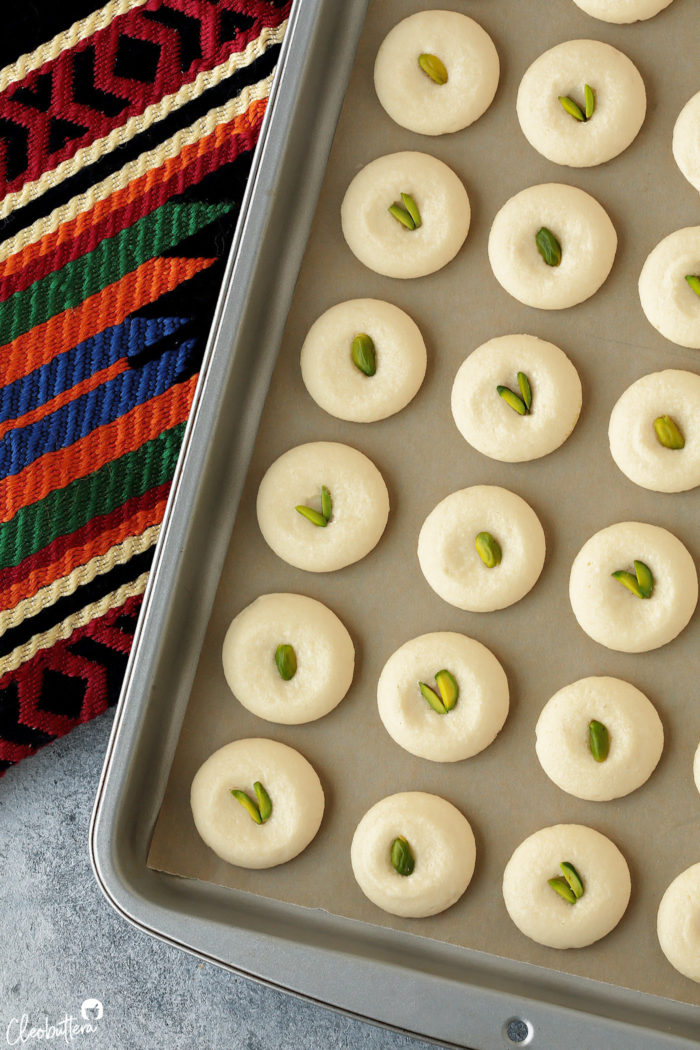
Why is it that the simplest things are always the hardest to get right?
Ghorayeba is a 3-ingredient, plain, seemingly simple drop cookie with no bells and whistles, and a straightforward flavor. How hard can it be?
Uhmmm…VERY!
Just like basbousa and red velvet cupcakes, these stubborn cookies drained the life out me, trying to get them the way they’re supposed to be.
I went through dozens and dozens of failed attempts, that I was this close to giving up on it and calling it quits.
But I’m glad I hung on for those last few trials, because they are what led to the The Perfect Ghorayeba.

What is Ghorayeba?
Ghorayeba can be described as the shortbread of the Middle East without the crunch. Barely sweet, with a pleasant ghee flavor, ever-so-slight bite and a delicate texture that melts away in the mouth.
The classic Egyptian type is flavored with nothing but the ghee its made with, while other parts of the Arab world like Syria and Lebanon, often flavor theirs with orange blossom and rose water, where its also slightly crunchier and pronounced ‘Graybeh’. Today, we’re focusing on the Egyptian variation.
Ghorayeba is most known for it’s distinctive fine crumb, smooth finish with a fuzzy outer layer and angelic off-white color. It has a cloud-like mouthfeel that disintegrates to the bite and a rich lightness like no cookie I know of.
The texture is everything when it comes to ghorayeba and I don’t think enough adjectives will ever do it justice. It’s just one of those things you need try to be able to know what it’s like.
Ghorayeba is a celebration cookie around these parts. In Egypt, where I’m from, they are especially baked for Eid, as well as Easter and Christmas. And just like kahk, no feast is complete without it.
There’s nothing I associate the end of Ramadan and arrival of Eid more, than when I see boxes of kahk and ghorayeba entering homes. They’re what people gift one another during that time of the year and an always welcomed tradition that is as old as time.
I get excited over well-made kahk just like every other Egyptian, but I’m personally Team Ghorayeba all the way. It’s that unique texture that wins me over every single time. It is just a thing of minimal beauty and hands down my favorite Eid cookie.
I have zero self-control over ghorayeba. Give me a box-full & 15 minutes, and you’ll see a miracle of disappearance happen.
And it seems I’m not alone on this. You guys are just as crazy about it and I know it! So many of you have been asking if I had a good recipe since I started the blog & the answer had always been a sad ‘no’.
And this just had to change.
But it was easier said than done.

My mission was to find a ghorayeba recipe that is:
- Sturdy, yet delicate.
- Melts-in-the-mouth.
- Fine textured.
- With a minimal bite; zero crunch.
- Rich in flavor, light in texture.
- Smooth finish without any cracks.
- Off-white in color.
- Just sweet enough.
- With a distinctive ghee flavor.
It was a long list and I wasn’t about to compromise.

I have tried so many recipes, that I’ve lost count. From cookbooks, websites, blogs, YouTube, you name the recipe, I’ve most likely tried it.
And what I got was: Hard, tough, crunchy, and cracked. But at least the flavor and color were there. Thank God!
I was pulling my hair out experimenting with different ingredient ratios, ovens temperatures, baking durations, to get that signature texture…but nope, it wasn’t happening. I even called for help on Instagram and many of you have been so kind with sharing your tips with me. Thank you guys!
And then it suddenly occurred to me to seek the advise of a pastry chef at my local bakery. I wasn’t sure if he was gonna pour out all his secrets…but my oh my there’s still good in this world.
Chef Beshoy not only shared his recipe with me, but walked me through every step, bared through the countless ghorayeba photos and videos I texted him, helped me troubleshoot and even taste tested the ones I baked for approval. I cannot be more grateful to this good-hearted human being. Because of his help, you and I now have all the secrets needed to make perfect ghorayeba at home just like the best bakeries in Egypt.

What’s so special about this recipe?
For starters, its coming out of the mouth a professional pastry chef, not a baking enthusiast like myself. I’m simply here to pass down what I’ve learned from him.
Technique-wise, this recipe is nothing like any of the recipes I’ve tried before. The ratios are almost the same…most of them are, but the mixing method is what makes all the difference.
Whereas most other recipes, call for kneading the ingredients just until a dough forms, some even cautioning about over-mixing and stress on handling the dough oh-so-gingerly, this one specifically asks you to beat the heck out of it. Trust me…this is the secret!
But won’t overmixing develop gluten?
Not here! In fact, we’re doing the complete opposite. Gluten starts to develop once liquid is added to flour, and there’s no liquid here. No milk, no water, nothing. Just flour, sugar and ghee. By beating the flour extensively with the ghee, you’re coating the flour particles with fat, and that actually inhibits gluten formation, giving us a more tender cookie. Smart, right?
You’ll want to beat the dough so much until it loosens up to a smooth, thick cake batter consistency. It will look exactly like hummus dip.
How will we roll the “dough” into balls if it’s so soft and batter-like?
We don’t. We pipe it like macarons.
Another departure from the regular recipes I’ve tried, Chef Beshoy pipes the ghorayeba instead of rolling it. Since the dough is so soft and sticky, I actually find piping so much easier than rolling into balls. I know some of you aren’t very comfortable with piping, so I found that cooling the dough for a couple of hours before rolling it into balls works too. I also feel that chilling the dough into a log then slicing it, as in slice-and-bake-style cookies, might also work, although I haven’t tried it. I know chef Beshoy wouldn’t approve, but I just want to help you find a way to make them, even if it means bending some rules.
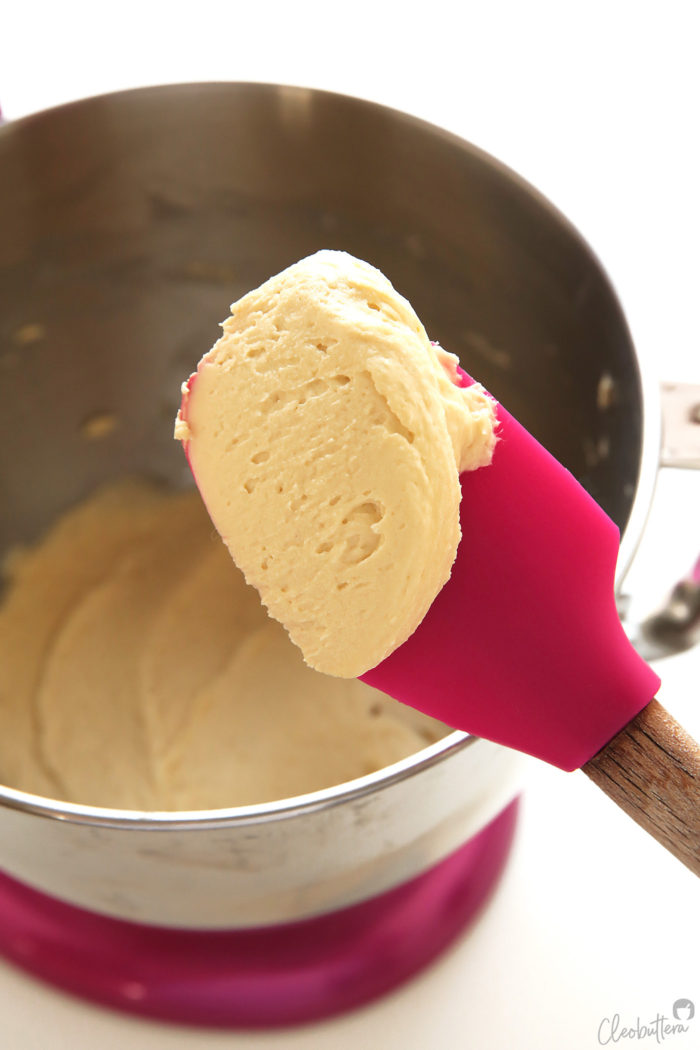
What do we need to make Ghorayeba?
As promised…only 3 ingredients!
Flour, powdered sugar and ghee.
Oh and some pistachios or any other nut you prefer, but you can totally leave them out if you’re not into nuts. My kids pick them out and eat the Ghorayeba plain.
Since very few ingredients make up this recipe, know that your ghorayeba will only taste as good as the ingredients you put in it, especially the ghee. So choose a ghee brand that you love and can tolerate its smell and taste. Some ghee types have an overpowering odor and a strong taste and I’m not a fan of those. So I like to go with something that tastes as close to butter as possible, but hey! you be you. Go with whatever you like, except butter…unfortunately. And as much as I hate to say it…straight up butter does not work here.
Why can’t I use butter?
Because butter is around 80% fat, 20% moisture, while ghee is near 100% fat. Remember, moisture develops gluten and we don’t want it here. So the moisture (milk and water) from the butter, will result in a tough, crunchy cookie.
What do I do if I don’t have ghee?
You can use clarified butter, where the milk solids have been removed instead. Just be sure to use it in its solid state though.
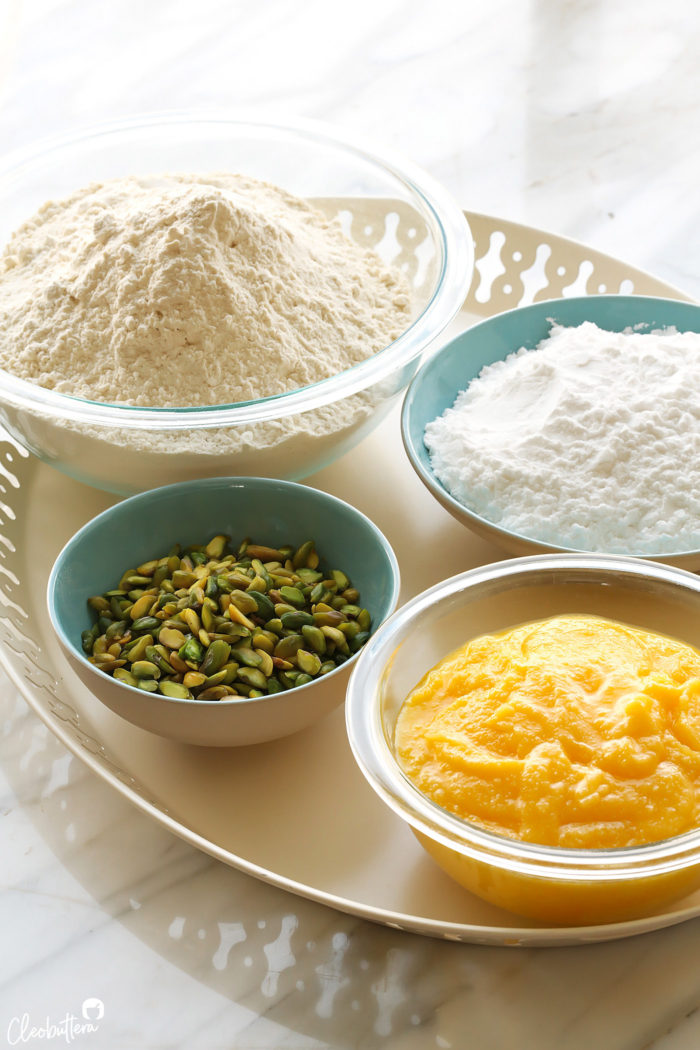
How to make the Perfect Ghorayeba?
Whisk together the flour and powdered sugar to combine. Then add in the ghee. I’ve tried both room temp and cold ghee (as many recipes recommend) and didn’t notice any difference in the results. So use whatever you prefer, as long as it’s not melted.
Then beat the mixture on low speed to combine. Dough will start out looking stiff the way cookie dough should be, and you’ll be tempted to stop here, but don’t. Keep mixing for another 5 minutes on medium low.

Then raise the speed to medium-high and beat for another 5 minutes. Dough will soften up significantly, but won’t be as smooth as we want it. So turn down the mixer to medium-low again and continue beating for another 5 minutes. That’s a total of 15 minutes! Your dough should now be very smooth, with no lumps and will look exactly like hummus. It will also be alarmingly sticky.
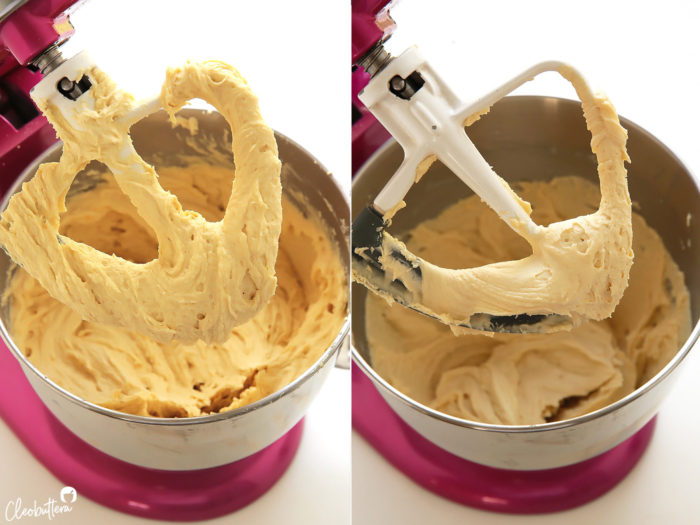
Now you have 2 options to getting the sticky dough from bowl to baking sheet.
- Piping method: (which I strongly recommend) due to the dough’s stickiness. Pipe 3.5-4cm rounds just like macaron.
- Roll and flatten method: (so nerve-wracking to be honest) but at least you have the choice . If you’ll go this route, then you’ll need to chill the dough long enough for it to firm enough to handle. Then roll into balls and flatten with the palm of your hand.
- Slice-and-bake method: (not pictured, not tested) but I think it will work well, albeit the won’t be ideal. Shape dough into a thin log over parchment paper or plastic wrap. Wrap it tightly, chill until firm, then slice into 1 cm thick round and bake!
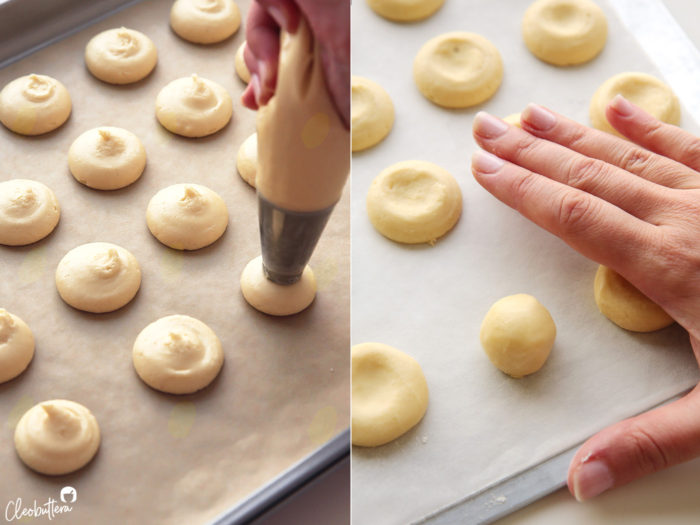
If you have any peaks popping out due to piping, simply chill the dough for about 5 minutes, so its no longer sticky but not firm, then tap them down with a floured finger.
Follow that with pressing a nut in the middle of each round.
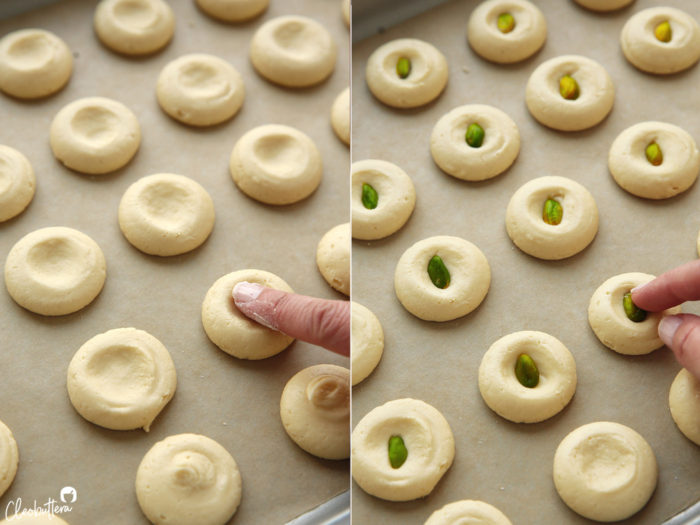
You’ll want to bake the cookies low and slow to maintain that pale color, while baking it all the way through. I found that a 120C oven for 17 minutes work perfectly in my oven, but that might not be the case for you. So I recommend baking a test batch before proceeding.
You just want to bake them until the cookies look set. The color should still remain off-white and the bottoms should not take on any color. They will feel set to the touch, firm but not hard at all and will leave dough residue on your finger if you touch them. Don’t worry, this will go out away once the cookies have cooled. They will continue to bake as they cool, so be sure to allow them to come to complete room temp before sampling.

And that is it!
You’ve just made bakery quality Ghorayeba you can be proud of.
Now pile them up in a pretty box (totally reused Ladurée’s signature box and yes it’s upside down ?)
Then give them away to your loved ones as quickly as possible…because you won’t be able to stop and your waistline will not forgive you for it.
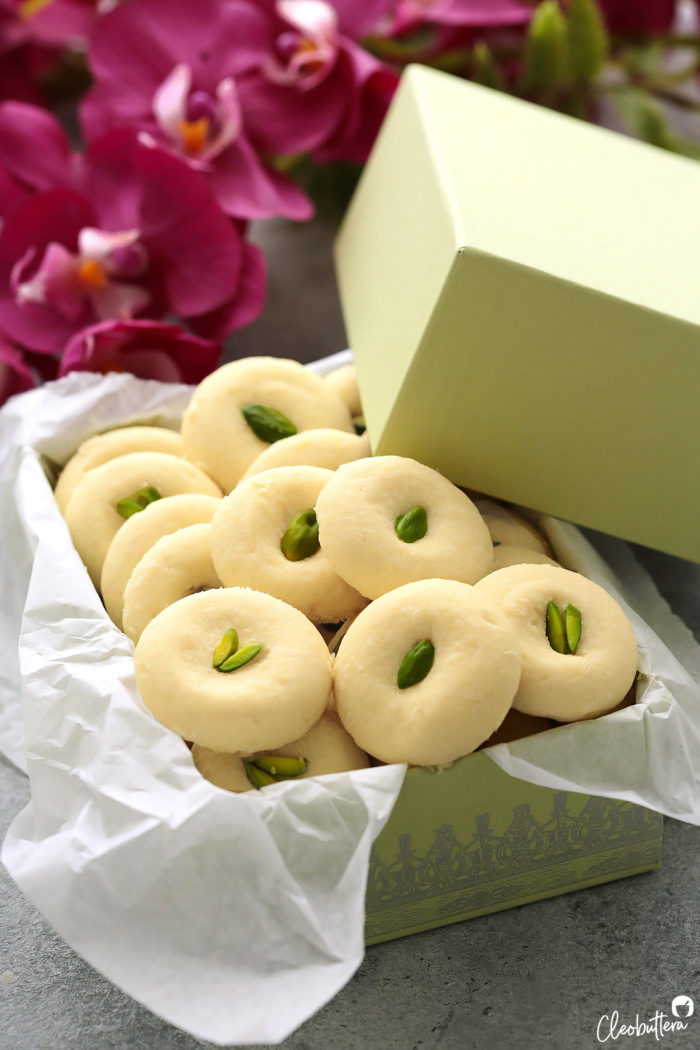
FAQs:
What can I use instead of ghee?
Clarified butter in its solid state. Store-bought or homemade will both work. Be sure to check out a YouTube tutorial to learn how to make it.
What if I don’t have a standmixer?
An electric handmixer will work just fine, but expect an arm’s workout ??
How long to do these cookies keep and how to store them?
Ghorayeba is one of those things that get better over time. I like them more after the second day they’re baked. I find that the texture improves as they sit and they get smoother and softer. They will keep well for 2 to 3 weeks at room temperature. Store in a regular container or box (not airtight).
How can I prepare these cookies in advance?
Shaped dough rounds can be kept in the refrigerator for 3 to 4 days, and in the freezer for 1 month. Bake straight from the fridge, increasing baking time by one minute. For frozen, bake straight from frozen increasing baking time by 2 to 3 minutes.
Can I double the recipe?
If you have a standard home-size stand mixer of about 5 quarts or less, then it’s not recommended. It will not be able to sufficiently beat the dough into the required level of smoothness. It’s better to prepare the dough in batches instead.
Can I halve the recipe?
Absolutely! It’s what I did when I was testing the recipe and it worked so well. You may also quarter it.
My ghorayeba came out hard. What did I do wrong?
Either 1) The flour and/or powdered sugar were over-measured (a common culprit of measuring cups), and for that I highly advise using a scale for all baking recipes, and particularly this one. 2) The dough was not mixed long enough. 3) The cookies were over-baked.
My Ghorayeba cracked. What did I do wrong?
Same as above 1) The flour and/or powdered sugar were over-measured (a common culprit of measuring cups), and for that I highly advise using a scale for all baking recipes, and particularly this one. 2) The dough was not mixed long enough. 3) The cookies were over-baked. 4) The oven temperature was too high.
My Ghorayeba dough was cracking as I was piping it. What did I do wrong?
This means that it hasn’t mixed long enough. You can fix this by returning the dough to the mixer and beating for longer, until it becomes so smooth.
Need a closer look?
Check out my video tutorial on my Instagram highlights labeled ‘Ghorayeba.’
The Perfect Ghorayeba
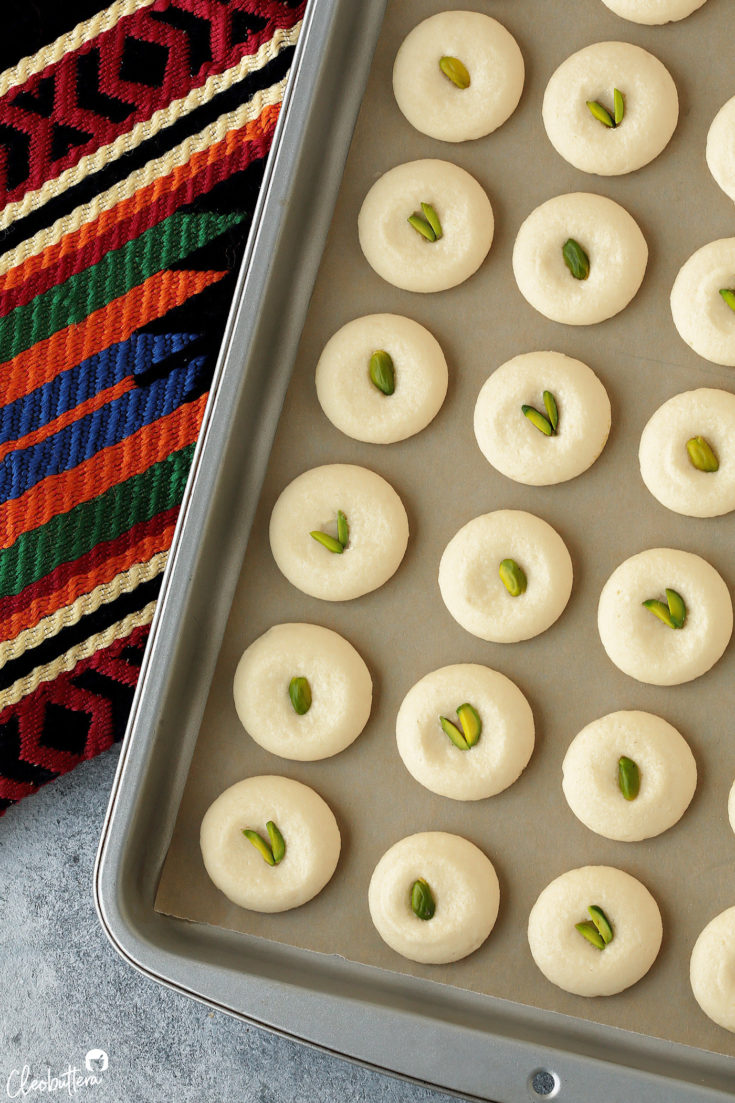
Perfected recipe for Egyptian, bakery-style Ghorayeba cookies! Delicate, fine-textured, smooth and melts in the mouth delicious.
Ingredients
For the Dough:
- 4 cups (500g) all purpose flour
- 1 1/3 to 1 1/2 cups (150g to 175g) powdered sugar, sifted*(see note below)
- 1 1/3 cup plus 1 tablespoon (300g) ghee, room temperature or cold
For Garnish: (optional)
- Pistachios (whole, halves or slices), or any nut of your choice
Instructions
- Adjust oven rack to middle position and preheat oven to 120C/248F. Line 2 baking sheets with parchment paper or silicon mats
- In the bowl of a stand mixer fitted the paddle attachment (or in a large bowl and an electric hand mixer), add the flour and powdered sugar, and whisk together to combine.
- Add in the ghee and mix on low speed until a crumbly dough starts to form. Continue beating for 5 minutes. I actually set a timer for this. The dough will start out very crumbly then stiff, but will soften up as the mixing progresses.
- Raise the speed to medium-high and mix for another 5 minutes. Then turn back the speed to low and continue beating for another 5 minutes. The dough needs to mix for a total of 15 minutes, or until very smooth with absolutely no lumps, and transforms to the consistency of thick cake batter and resembles smooth hummus dip. It will be sticky, and not dough-like, so don't be tempted to add more flour.
- Transfer the dough to a piping bag fitted with a large round tip (I use Ateco 808). Holding the piping bag at a 90-degree angle over the prepared baking sheets, pipe 3.5-4 cm rounds of dough, spacing them 2cm apart. If the rounds are cracking as you're piping, it means that the dough needs to be beaten for longer (For alternate shaping methods, refer to recipe notes 4 and 5). Refrigerate the baking sheet until the dough rounds are no longer sticky to the touch, but is still soft; 5 to 10 minutes.
- Using a lightly floured finger, gently tap on the peaks to flatten. Press a pistachio half (or whole if you like) in the middle of dough round.
- Bake for 17 minutes, just until the cookies look set. The color should still remain off-white and the bottoms should not take on any color. They will feel set to the touch, but not hard and will leave dough residue on your finger if you touch them. Don't worry, this will go out away once the cookies have cooled. It is really important not to over-bake these cookies, or they'll end up really tough and hard. (Since each oven runs differently and it's difficult to judge when they're done, it is recommended that you bake a test batch of 8 or so first, to figure out the perfect baking duration for your oven. Mine are perfect after exactly 17 minutes, but that might not be the case for everyone).
- Allow the cookies to cool on the baking sheets. If you need the baking sheet for another batch, just slide the parchment paper with the cookies off on to a counter to continue to cool completely. Ghorayeba will continue to bake as they cool, so be sure to allow them to come to complete room temp before sampling.
- Leave the cookies out for at least two hours or even overnight before storing or boxing, so the thin layer of film around them can set and disappear.
- Store ghorayeba in a regular container or box (not airtight) for 2 to 3 weeks at room temperature. Texture improves after the second day they're baked. The surface becomes smoother and the cookies get softer overall.
Recipe Notes
- The amount of sugar is according to preference. Chef Beshoy's recipe calls for 150g of sugar, but I personally prefer the extra sweetness of 175g. You can use either or, or something in between; no more, no less. Note that the less the sugar, the finer the texture will be.
- Ghee may be substituted with clarified butter at its solid state. Regular butter will not work here.
- My preferred brand of ghee is Best Sheraton.
- Be sure to use good quality, store-bought powdered sugar; the finer the better. Home-made powdered sugar will not work here.
- It is highly advised to use the piping method to portion out your dough, as rolling could be messy due to the stickiness of the dough. If you're not comfortable with piping, you can shape the dough by hand. First, you'll need to refrigerate the dough for about 2 hours or until firm but not rock solid, as it's too sticky to handle while at room temperature. Then taking 2 teaspoon-sized pieces of dough, use your hand to roll into balls. Place the ball on the baking sheet, then use the palm of you're hand to flatten. Press with a pistachio.
- As another shaping alternative, you may want to consider the slice-and-bake method. I have not tried it but I think it will work well, albeit the shape won't be ideal. Shape dough into a thin log over parchment paper or plastic wrap. Wrap it tightly, chill until firm, then slice into 1 cm thick rounds and bake!
- Doubling the dough amount is not recommend unless you have a bakery size stand-mixer. Most home-mixers, which are around 5-quarts, will not be able to sufficiently beat the dough into the required level of smoothness. You may halve or quarter the recipe though.
Recipe adapted from Chef Beshoy.
Measurements Note: All recipes of this site have been developed using weight measurements. Although US volume measurements have been included for your convenience, it is highly encouraged that you weigh your ingredients using a kitchen scale to get the best possible results. Due to the sensitive nature of baking, kitchen scales are proven to yield more accurate and consistent results than measuring cups. Enjoy!
This post may contain affiliate links.
All images and content are owned by Cleobuttera® and are copyright protected. Please do not use my images without prior permission. If you would like to republish a recipe, please rewrite it in your own words and link back to the recipe page on my site. Original recipes and creations of this site are intended for personal and home use. Commercial replication or media consumption are only allowed with a written consent and agreement with Cleobuttera owners. Otherwise it is considered a violation of intellectual property. Thank you for respecting and appreciating the amount of time and effort that goes into creating free, unique recipes that make people happy.

